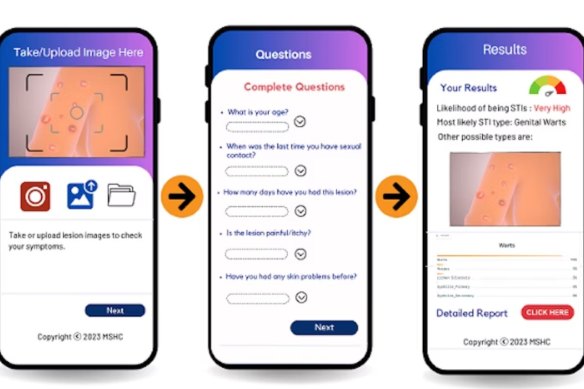- Exclusive
- National
- Sexual health
This was published 9 months ago
Using AI, this app may tell if you have an STI
By Mary Ward
An app developed by Australian researchers is showing promise in diagnosing sexually transmitted infections (STIs) using artificial intelligence, amid a surge of people testing positive to the diseases.
There has been a post-pandemic upswing in cases of chlamydia, gonorrhea and syphilis, a trend attributed to increased testing but also a decline in condom use.

Professor Lei Zhang says more than half of people coming to his sexual health centre do not have an STI. Credit: Chris Hopkins
Australia is also in the midst of an outbreak of mpox, formerly known as monkeypox, with 28 cases reported in the fortnight ending June 23. The outbreak is being driven by local transmission rather than people bringing the disease from overseas, say federal health authorities. Most cases were recorded in Victoria, followed by Queensland.
Researchers at Monash University and Alfred Health’s Melbourne Sexual Health Centre hope their new app will give patients an embarrassment-free way to learn whether their bumps or rashes are a possible STI.
The app compares photos of a patient’s lesions to a database of hundreds of thousands of anonymised photos of rashes and lesions in people diagnosed with HIV, syphilis, gonorrhea and chlamydia, taken with patients’ consent from more than a decade of consultations data.
A trial of the app across more than 1300 consultations at the clinic, led by PhD candidate Nyi Nyi Soe and published in the Journal of Infection, found it correctly identified cases of mpox with 80 to 90 per cent accuracy when used by clinicians with patients at the centre.

The Australian-developed AI model is able to fairly accurately distinguish between STIs from a patient image.
“It is a quite reasonable result,” said Professor Lei Zhang, from the Melbourne Sexual Health Centre and head of the team creating the app. “Clinically, we would like the accuracy to reach 95 per cent, but we haven’t arrived there yet because we haven’t got enough images.”
The research team next plans to run the same trial on seven other STIs. Ideally, the app would be able to be used for both STIs and other skin lesions in the future.
But Zhang said he did not think the app would, or should, replace the role of doctors and pathology in diagnosing an STI. Any suspected STI identified by the app would still need to be confirmed through lab testing.
The major benefit, he said, would be saving people from coming into a sexual health clinic if they clearly did not have an STI.
“More than half of the people who come into our clinic are fine; they have a lesion but it is not an STI,” Zhang said.
“We don’t want to replace lab diagnosis. We want to demonstrate that the concept actually works, and the tool is benefiting both patients and doctors.”
A similar app, HeHealth, is on the market in Singapore. However, this app’s model has only been trained on pictures of men’s genitals.
“Our app can be used by men and women, and on different parts of the body,” Zhang said.
Data from the federal government’s National Communicable Diseases Surveillance Report shows there have been 10,000 more chlamydia notifications and 11,000 more gonorrhea infections in the past year than the five-year average.
Dr Sara Whitburn, chair of sexual health medicine at the Royal Australian College of GPs, said the increase was not necessarily a bad thing.
“People are coming in and getting tested, and that is a good thing,” she said.
“But we also know that, post-pandemic, people are engaging in sexual activity with a broader range of partners.”
Whitburn said condom use was also declining for multiple groups, particularly men who have sex with men and now have access to pre-exposure prophylaxis (PrEP) medication to prevent HIV transmission.
“That is also, in part, a good news story, but the message that you still need safer sex with condoms to protect against gonorrhea or syphilis may not be as strong as a result,” she said.
Young women are also choosing contraceptive methods such as IUD and the pill instead of condoms, and disrupted sex education in the pandemic may mean they do not understand the importance of barrier protection to prevent STIs.
“Then we also have people who are older and are repartnering after a long-term relationship, and the sexual health that worked for them in a relationship may not be what they need now,” Whitburn added.
Whitburn said, while she agreed the app would not be able to be used to diagnose STIs, introducing an anonymous, easy step to identifying whether a rash is a potential STI could be useful.
“If it lets someone know there is a strong possibility that their rash is an STI, they can go and take that step to get testing, especially if the app contains information showing people that there are treatments,” she said.
“Sometimes people feel that, if they get tested, it will impact their sexual health long-term. But actually, testing and treating is the pathway to good sexual health.”
Make the most of your health, relationships, fitness and nutrition with our Live Well newsletter. Get it in your inbox every Monday.